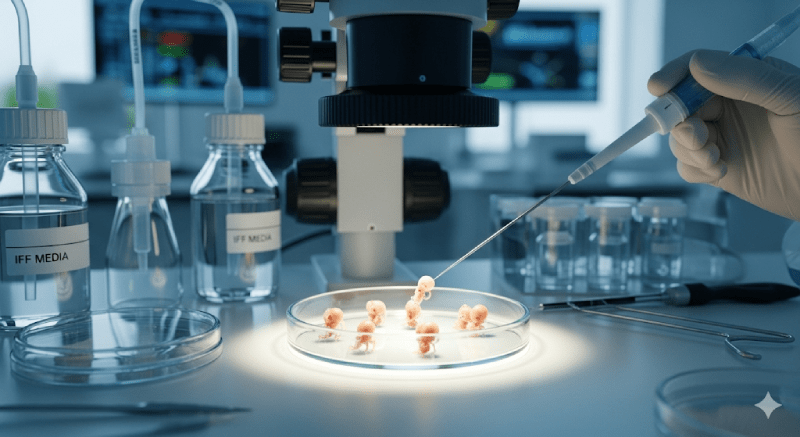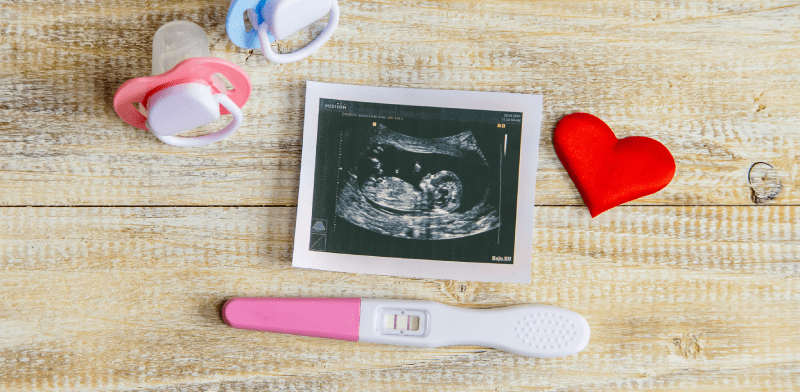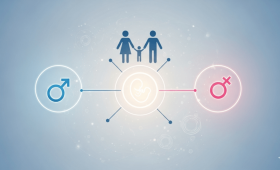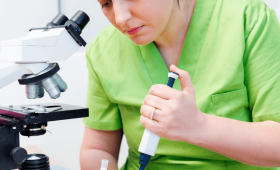The IVF Journey: A Detailed Medical Guide
In vitro fertilization (IVF) is a medical process that has transformed the landscape of reproductive medicine. The IVF journey is a multi-stage process that, from start to finish, can typically span 6 to 8 weeks. While the overarching framework is consistent, each cycle is a deeply personalized experience tailored to the individual patient. The process is a careful orchestration of medical science, advanced technology, and patient care, designed to maximize the chances of a successful pregnancy.
The Foundational Step: Initial Consultation and Evaluation
The IVF process begins not with a procedure, but with a comprehensive initial consultation with a reproductive endocrinologist. This foundational step is critical for developing a personalized treatment plan that addresses the specific needs of the prospective patient. The physician will conduct a thorough review of the patient’s medical history and fertility goals and recommend a series of diagnostic tests. These tests are essential for identifying any underlying factors contributing to infertility and for gauging the patient’s reproductive health. The diagnostic battery may include bloodwork to assess hormonal levels, ultrasounds to evaluate the uterus and ovaries, and semen analysis for male partners.
A common misconception is that IVF is a standardized, one-size-fits-all procedure. However, the initial evaluation phase highlights the deeply individualized nature of the treatment. The findings from these tests directly inform the specific protocol for the patient, from the type and dosage of medications to the choice of laboratory procedures. While an essential prerequisite, this initial consultation is not without cost, often ranging from $200 to $289 or more, representing the first financial commitment of the journey.
Ovarian Stimulation: The Engine of IVF
Following the initial evaluation, the ovarian stimulation phase begins. During a natural menstrual cycle, the ovaries typically release a single mature egg. The objective of this IVF stage is to use fertility medications to encourage the ovaries to produce and mature numerous eggs. This increases the number of eggs available for retrieval and subsequent fertilization, which in turn improves the overall chances of success.
The patient self-administers these fertility drugs, which are typically injections of hormones such as gonadotropins, for an average of 8 to 14 days. The exact duration and dosage depend on the individual’s response to the medication. This phase is highly monitored, requiring frequent visits to the fertility clinic for blood tests and transvaginal ultrasounds. This consistent monitoring allows the fertility specialist to track the development of ovarian follicles and hormonal responses, enabling them to make timely adjustments to the medication dosage or protocol as needed. This dynamic, responsive approach is key to optimizing the cycle’s outcome and managing potential side effects, such as ovarian hyperstimulation syndrome (OHSS).
The Egg Retrieval Procedure
When monitoring indicates that the ovarian follicles have reached an adequate size, the eggs are ready for retrieval. This is a minor, outpatient surgical procedure performed at the fertility center under mild sedation. With the aid of ultrasound visualization, the physician guides a thin needle through the vaginal wall and into the ovaries to aspirate the eggs from the follicles. The procedure typically takes around 20 minutes, during which multiple eggs are collected. On the same day, if a male partner’s sperm is being used, a semen sample is collected.
The use of intravenous or mild sedation during the procedure directly addresses the prospective patient’s natural concern about discomfort. The presence of an anesthesiologist is a standard practice that provides an additional layer of safety and reassurance. The entire process is designed to be as efficient and comfortable as possible while maximizing the number of eggs retrieved for the next critical stage of the process.
The Laboratory: Fertilization and Embryo Culture
Once retrieved, the eggs are immediately transported to the embryology laboratory for fertilization. This is the “in vitro” portion of the procedure, where eggs and sperm are combined outside the body. Fertilization can be performed using one of two primary methods:
- Conventional Insemination: In this method, a sample of healthy sperm is mixed with the eggs in a laboratory petri dish and left to incubate overnight, allowing fertilization to occur naturally.
- Intracytoplasmic Sperm Injection (ICSI): This advanced technique involves the injection of a single sperm directly into a mature egg. ICSI is typically used to overcome issues of male factor infertility, such as a low sperm count or poor sperm motility.
After fertilization, the newly formed embryos are meticulously monitored by embryologists as they develop over the next several days. They are assessed for quality and viability as they grow from a two-cell stage to four, then eight, and ultimately to the blastocyst stage, which typically takes five to six days. At this stage, preimplantation genetic testing (PGT) can be performed to screen the embryos for chromosomal abnormalities or specific genetic diseases. PGT is a significant laboratory procedure that, while adding to the overall cost, can help reduce the risk of miscarriage and genetic disorders by ensuring that only chromosomally sound embryos are selected for transfer. The technology in the embryology lab is not merely supportive but is a core element of the treatment itself. The choice to use ICSI or PGT is a medical one based on the initial diagnosis, illustrating how the entire process is a series of interconnected, data-driven decisions.
The Embryo Transfer: The Final Step
The embryo transfer is the final clinical step of the IVF cycle. It is a quick and simple procedure that is rarely described as requiring sedation or anesthesia. During the transfer, the physician uses a long, thin catheter to pass the chosen embryo or embryos through the cervix and into the uterus. An abdominal ultrasound is simultaneously performed to ensure the optimal placement of the embryo(s) within the uterine cavity.
Modern practice and the goal of ensuring the safest possible outcome for both the mother and the baby have led to a clear trend toward single-embryo transfer. This strategy helps to limit the number of multiple births, which carry increased risks. At some fertility centers, more than 60 percent of embryo transfers involve a single embryo, reflecting the medical community’s commitment to this practice.
The Two-Week Wait and Beyond
After the embryo transfer, a period of anticipation begins, often referred to as the “two-week wait.” Patients are typically instructed to limit strenuous physical activity and may remain on hormonal support to assist with the uterine lining. Approximately nine to fourteen days after the transfer, a blood test is performed to determine if the cycle has resulted in a pregnancy. If the test is positive, the patient transitions to prenatal care. If the test is negative, the medical team will review the results with the patient to discuss the next steps, which may include another IVF cycle or an alternative treatment plan. This final stage of the cycle underscores the emotional journey and the potential need for multiple attempts, which has significant financial and psychological implications.
The entire process, from the initial consult to the pregnancy test, can be summarized in a chronological flow as shown in the table below.
Table 1: IVF Cycle Stages and Timeline
| Stage | Description | Typical Timeline |
| Initial Consultation | Review of medical history, fertility goals, and initial diagnostic tests (bloodwork, ultrasound, semen analysis). | 1-3 weeks |
| Ovarian Stimulation | Daily self-administration of injectable fertility medications to produce multiple eggs, with regular monitoring via blood tests and ultrasounds. | 8-14 days |
| Egg Retrieval | A minor outpatient procedure under sedation to collect mature eggs from the ovaries. | 20-30 minutes |
| Fertilization & Culture | Eggs are fertilized with sperm in the lab (conventional or ICSI), and embryos are cultured and monitored for several days. | 3-5 days (until blastocyst stage) |
| Embryo Transfer | A quick, ultrasound-guided procedure to place a high-quality embryo into the uterus. | 15-20 minutes |
| The Two-Week Wait | The period between transfer and the pregnancy blood test to check for a successful implantation. | 9-14 days |
Navigating the Financial Landscape: A Comprehensive Cost Breakdown for 2025
The financial aspect of IVF is often as complex and demanding as the medical process itself. A single IVF cycle in the United States can be a significant investment, and a clear understanding of the costs is essential for any prospective patient. The fees are not a flat, all-inclusive price but are instead a modular structure with a base cost and numerous variable and optional add-ons.
The Anatomy of an IVF Bill: What’s Included and What’s Not
The average base cost for a single IVF cycle in the United States typically ranges from $12,000 to $18,000. According to the American Society for Reproductive Medicine, this base price is closer to an average of $12,400. This figure generally covers the core clinical procedures, including the egg retrieval, laboratory fertilization and culture, and the embryo transfer.
However, this base price is a significant but misleading figure. It is designed to represent the core procedural cost but often excludes several key components. The base fee frequently does not include the cost of fertility medications, anesthesia for the retrieval procedure, or diagnostic and monitoring tests. A patient who budgets only for the base price will quickly find that their out-of-pocket expenses are substantially higher. The transparency of this pricing model varies by clinic; some bundle these costs while others list them separately, so it is critical for prospective patients to obtain a detailed, itemized cost estimate from their clinic.
The Variable Expenses: Medications and Add-Ons
The total cost of an IVF cycle is a modular sum, and the final price is determined by the combination of services a patient’s treatment plan requires. These add-ons, while sometimes listed as “optional,” are often medically necessary and significantly increase the total financial burden. The total cost of one IVF cycle, including medications and other services, can easily range from $15,000 to $30,000 or more.
The most significant variable costs include:
- Medications: The cost of injectable fertility medications is a major expense, typically ranging from $3,000 to $8,000 per cycle. This cost is often dependent on the prescribed protocol and the patient’s individual dosage requirements.
- Intracytoplasmic Sperm Injection (ICSI): This procedure, which is essential for male factor infertility, adds an additional $1,500 to $3,000 to the total cost.
- Preimplantation Genetic Testing (PGT): PGT screens embryos for chromosomal integrity and is a powerful tool for improving outcomes, but it comes with a price tag of $3,000 to $6,000.
- Embryo Cryopreservation and Storage: Freezing and storing any excess embryos is a common practice that costs approximately $1,000 to $1,900 for the first year, with annual storage fees ranging from $600 to $1,500 thereafter.
- Frozen Embryo Transfer (FET): If a frozen embryo is transferred in a subsequent cycle, it incurs an additional cost of $3,000 to $6,000.
The patient’s final bill is a direct reflection of their personalized treatment plan. A patient in need of ICSI and PGT, which are often recommended for specific diagnoses, will face a significantly higher total cost than a patient without those needs.
Table 2: Estimated Costs of a Single IVF Cycle (2025)
| Itemized Cost Breakdown | Estimated Average Cost (USD) |
| Base IVF Cycle | $12,000 – $18,000 |
| Fertility Medications (Injectable) | $3,000 – $8,000 |
| Intracytoplasmic Sperm Injection (ICSI) | $1,500 – $3,000 |
| Preimplantation Genetic Testing (PGT) | $3,000 – $6,000 |
| Embryo Cryopreservation (first year) | $1,000 – $1,900 |
| Annual Embryo Storage Fee | $600 – $1,500 |
| Frozen Embryo Transfer (FET) | $3,000 – $6,000 |
| Anesthesia for Egg Retrieval | $690 – $1,227 |
| Initial Consult & Diagnostics | $289 – $1,639 |
| Total Cost per Cycle (with medications and add-ons) | $15,000 – $30,000+ |
Cost Factors Influencing the Final Price
The final cost of IVF is not just about the services but also about external factors that can dramatically shift the price. The geographic location of the clinic is a major factor, with costs varying significantly by region. For example, the average total cost in Los Angeles can exceed $25,000, while in Boston, it is over $20,000. The number of cycles needed is the most significant factor affecting the total lifetime cost of treatment. The statistical reality is that most patients require more than one cycle to achieve a successful live birth. The average patient undergoes between 2.3 and 2.7 cycles, leading to a total average expenditure of close to $50,000. This financial reality is a primary reason why a large percentage of individuals who need IVF do not even begin the process. The high cost of a single cycle, coupled with the statistical likelihood of needing multiple attempts, creates a substantial financial barrier that can be insurmountable for many.

Alternative IVF Protocols: Cost vs. Efficacy
To address the high cost and reduce the patient burden, some clinics offer alternative protocols that use less medication. However, a crucial trade-off exists between cost and efficacy.
- Mini-IVF (Minimal Stimulation IVF): This approach uses lower doses of fertility medications, which reduces the cost of a cycle to approximately $8,500, compared to the $17,000 cost of a standard cycle with medications. The lower cost is a result of less medication, fewer office visits, and reduced laboratory supplies. Mini-IVF can also reduce the risk of OHSS and produces fewer excess embryos. While it may be slightly less effective for younger women under 35, it can be superior to standard IVF for women over 43, for whom a full dose of medication is often ineffective.
- Natural Cycle IVF: This is an approach that uses minimal or no medication to stimulate only one egg. It is very low cost and eliminates the risk of OHSS. While more affordable, it has a lower success rate per egg retrieval than conventional IVF and may require multiple attempts to achieve a live birth.
- In Vitro Maturation (IVM): IVM involves retrieving immature eggs and maturing them in the laboratory. This protocol uses significantly less medication and requires fewer injections and monitoring visits, reducing the financial and emotional burden compared to traditional IVF. However, pregnancy rates with IVM may be lower, and the technology is not applicable to every patient; it is generally recommended only for those with a high antral follicle count.
The choice of protocol is not just financial but a deeply personal medical decision that must be made in consultation with a fertility specialist. The decision to opt for a lower-cost protocol may mean a higher number of cycles are needed to achieve a successful outcome, but it can make treatment possible for those who would not be able to afford a standard cycle.
Table 4: Comparative Analysis of IVF Protocols
| Feature | Standard IVF | Mini-IVF | Natural Cycle IVF |
| Cost | $17,000+ with medications | $8,500+ with medications | Very low cost (fees may be 30-50% less than stimulated cycle) |
| Medication Use | High doses of injectable hormones (gonadotropins) to stimulate multiple eggs. | Low doses of oral medication (Clomid) and/or very low dose gonadotropins. | Very little or no medication; oral medication may be used to enhance natural development. |
| Eggs Retrieved | Goal is to retrieve 10-15+ eggs. Often results in excess embryos for freezing. | Fewer eggs retrieved; results in fewer or no excess embryos. | Usually only one follicle is produced, yielding one egg. |
| Ideal Candidate Profile | Women of all ages, particularly those seeking to maximize eggs and embryos. | Women with low ovarian reserve, women over age 43, and those with tubal factor infertility. | Patients who are not candidates for or do not want high doses of hormones. |
| Success Rate per Cycle | Higher than Mini-IVF for younger women (50-55% for under 35). | Lower than Standard IVF for younger women, but superior for older women. | Lower success rate per egg retrieval; requires multiple attempts. |
Understanding Success Rates and Expectations
For prospective parents, understanding the statistical likelihood of success is a critical part of the IVF journey. However, a singular focus on a single-cycle success rate can be misleading and can obscure the true odds of achieving a live birth. The crucial distinction lies between a single-cycle live birth rate and the cumulative live birth rate over multiple cycles.
Statistics and Nuance: Single-Cycle vs. Cumulative Rates
The data clearly indicates that most people who undergo IVF, regardless of their age, do not have a baby after a single cycle. A single cycle is often just one step on a longer path. For this reason, the cumulative live birth rate—the chance of having a baby after multiple cycles—is a far more meaningful metric. The odds of a successful outcome increase significantly with each subsequent cycle, demonstrating that persistence is a key factor in success. For example, while a woman aged 30-31 has a 48% chance of a live birth after one cycle, that chance increases to 61% after two cycles and 67% after three.
Success rates are not uniform; they are deeply tied to a patient’s age and diagnosis, and the data provides a clear picture of this reality.
Table 3: IVF Live Birth Success Rates by Age and Cycle
| Woman’s Age at First IVF Cycle | Live Birth Rate after First Cycle | Live Birth Rate after Second Cycle | Live Birth Rate after Third Cycle |
| Under 30 | 43% | 59% | 66% |
| 30-31 | 48% | 61% | 67% |
| 32-33 | 44% | 60% | 67% |
| 34-35 | 40% | 54% | 61% |
| 36-37 | 32% | 44% | 50% |
| 38-39 | 22% | 32% | 38% |
| 40-41 | 13% | 21% | 25% |
| 42-43 | 6% | 10% | 11% |
| 44+ | 2% | 5% | 5% |
Data based on live births per stimulated IVF cycle
The data shows a clear and progressive decline in live birth rates with advancing age. Women under 35 have the highest single-cycle success rates, with approximately 50-55% achieving a live birth. This is largely due to better egg quality and overall reproductive health. For women over 40, success rates with their own eggs drop to 10-25% per cycle , and for those over 42-43, the rate can fall to under 5%. At this point, many specialists recommend considering the use of donor eggs, which can dramatically increase success rates to 70-80%.
Factors That Influence Individual Success
While age is the most significant factor, an individual’s success is a multifaceted equation influenced by a variety of elements. The specific infertility diagnosis, the partner’s health, and the patient’s ovarian reserve all play a critical role in the outcome. Beyond medical factors, lifestyle choices also have a demonstrable impact. Maintaining a healthy weight, eating a nutritious diet, avoiding smoking, and managing stress can positively influence egg quality and treatment outcomes. The expertise and technology of the fertility clinic are also significant factors; success rates can vary substantially between clinics. By focusing on controllable factors such as personal health and clinic selection, a patient can take a more proactive role in their fertility journey and improve their chances of a positive outcome.

Making IVF Accessible: Financial Solutions and Policy
The high cost of IVF, particularly the cumulative cost over multiple cycles, is a primary barrier to access. In response to this challenge, a robust ecosystem of financial solutions and supportive policies has emerged to help prospective parents navigate the financial landscape.
Financial Planning and Support
A variety of financial tools and resources are available to help make IVF more affordable and manageable. Many patients use personal savings, but a growing number are turning to specialized financing options. A number of lenders and organizations, such as CareCredit and ARC Fertility, offer personal loans specifically designed to cover fertility treatment expenses. These loans, which can range from $5,000 to $50,000, help to spread the cost into manageable monthly payments.
Many fertility clinics and third-party companies also offer multi-cycle packages that combine multiple rounds of treatment into one discounted price. These packages often include a shared-risk or refund component, providing a degree of financial peace of mind. Patients can also leverage tax-advantaged accounts such as a Health Savings Account (HSA) or Flexible Spending Account (FSA) to pay for qualified medical expenses with pre-tax dollars. Furthermore, IVF costs may be tax-deductible if they exceed 7.5% of a patient’s adjusted gross income.
Grants and Charities: A Resource Guide
For those who are unable to finance treatment through savings or loans, a large and fragmented ecosystem of non-profit organizations offers financial assistance in the form of grants and scholarships. These programs are often aimed at specific demographics or patient profiles, and a diligent search can yield significant support. A few examples of these programs include:
- National Programs: Organizations like the Cade Foundation, the Baby Quest Foundation, and The Gift of Parenthood offer grants that can be used for various assisted reproductive expenses, including IVF, egg and sperm donation, and surrogacy.
- Patient-Specific Programs: Grants are available for veterans through the Bob Woodruff Foundation , for cancer survivors via The Samfund , and for Jewish families through organizations like Hasidah.
- State-Specific Programs: Financial aid can also be geographically restricted. The Feit 4 KidZ Fertility Loan Fund offers interest-free loans in the Los Angeles and Ventura areas of Southern California, while Parental Hope awards grants in Ohio that cover the full cost of a single IVF cycle or a Frozen Embryo Transfer.
This wide array of grants and charities demonstrates that IVF affordability is a widespread societal concern, and a significant network of support exists to help bridge the financial gap.
Insurance Coverage and Policy Changes in 2025
The year 2025 has seen significant movement in the policy landscape, with a clear trend toward expanding access to IVF through legislative action. This represents a pivotal shift, moving IVF from a niche medical concern to a mainstream public policy issue.
- Federal Policies: In a notable development, a federal executive order was signed in February 2025 with the aim of expanding access to IVF and reducing out-of-pocket costs. This is seen as a redefinition of federal priorities, addressing infertility as a medical condition rather than an elective procedure. This executive order could provide favorable momentum for a bill in the Senate, the “Family Building FEHB Fairness Act,” which seeks to mandate fertility coverage for federal employees.
- State Policies: At the state level, several jurisdictions have enacted legislation to protect and expand IVF access. In July 2025, both Tennessee and Georgia codified access to IVF and other fertility services. Virginia also took steps in May 2025 to consider adding coverage for infertility treatments. In California, a mandate requiring large-group health plans to cover infertility treatments is set to take effect in 2026.
These policy changes signal a growing recognition of the importance of family building and the need to address the financial and logistical barriers that prevent many from seeking treatment.
The Future of Fertility: Innovations and the Political Climate in 2025
The field of reproductive medicine is in a state of rapid evolution. The landscape of 2025 is defined by a convergence of cutting-edge technology and a complex, often conflicting, political environment.
Technological Advancements
Innovations in technology are making IVF more effective, safer, and less invasive than ever before. This is not just a gradual improvement but a fundamental transformation of how fertility care is delivered.
- Artificial Intelligence (AI): AI is revolutionizing embryo selection. Advanced algorithms are now capable of analyzing images of embryos to predict which have the highest likelihood of successful implantation, a data-driven approach that reduces human subjectivity and improves pregnancy success rates.
- Non-Invasive Genetic Testing: Traditional genetic testing requires an invasive biopsy of the embryo. However, new methods are emerging that can analyze the spent fluid in which embryos are cultured, providing valuable genetic insights without the need for a biopsy. This advancement could reduce risks to the embryo and lower costs, making genetic screening more universal.
- Improved Cryopreservation: Breakthroughs in the vitrification process—a flash-freezing technique—have significantly enhanced the survival rates of eggs and embryos after they are thawed. Modern vitrification techniques now boast survival rates above 90%, providing a more reliable option for individuals who wish to preserve their fertility for the future.
The Duality of the Political Landscape in 2025
While policy and technology are pushing for greater access to IVF, there exists a powerful ideological movement that seeks to restrict it. The political landscape of 2025 is marked by a fundamental conflict between forces that aim to expand access and those that seek to limit it. A conservative blueprint, “Project 2025,” suggests making in vitro fertilization “fully obsolete and ethically unthinkable” based on the belief that life begins at conception. This so-called “personhood” language could be used to ban not only abortion but also assisted fertility treatments like IVF. This presents a clear, existential risk to the future of IVF in the United States and creates a climate of profound uncertainty for prospective parents. This tension between legislative expansion and ideological opposition is a defining characteristic of the fertility landscape in 2025.
Evolving Pricing Models: From “Pay Per Treatment” to “Pay for Baby”
Technological advancements are not only improving medical outcomes but are also poised to revolutionize the business model of fertility care. The traditional “pay per treatment” model places all the financial risk on the patient. However, with the rise of AI-powered embryo selection, clinics are gaining more confidence in their ability to predict successful outcomes. This increased predictive power is enabling a shift toward a “pay for baby” model, where the clinic and patient share the risk of treatment. In this model, clinics may offer a refund or a shared-risk plan if a live birth is not achieved after a certain number of cycles. This structural change, enabled by technology, would significantly benefit patients by reducing the financial risk of a failed cycle and making the path to parenthood more accessible.
Conclusion and Actionable Recommendations
In 2025, IVF remains a complex but highly effective medical solution for infertility. The journey is defined by a series of precise medical stages, a significant financial commitment, and a constantly evolving landscape of technology and policy. For those considering this path, a proactive and well-informed approach is essential.
Based on the current data and trends, the following recommendations are provided for prospective parents:
- Understand the Full Financial Picture: A patient should not be misled by a clinic’s base price. It is critical to obtain a detailed, itemized cost estimate that includes medications, anesthesia, and any necessary add-ons like ICSI and PGT. Acknowledging that the average patient requires more than one cycle is key to realistic financial planning.
- Consider All Protocol Options: Standard IVF is not the only path. Prospective patients should consult with their specialist about the potential benefits of Mini-IVF, Natural Cycle IVF, or IVM, particularly if age or financial limitations are a concern.
- Focus on the Cumulative Success Rate: Single-cycle success rates can be discouraging. The true measure of an individual’s odds is the cumulative live birth rate over multiple cycles. Patients should inquire about their clinic’s cumulative success rates for their specific age group and diagnosis.
- Explore Every Financial Avenue: A wide range of financial assistance is available. Patients should diligently research and apply for specialized loans, multi-cycle packages, and grants from the many national and state-specific organizations that exist to alleviate the financial burden of IVF.
- Stay Informed About Policy: The political landscape is in flux. A patient should remain aware of federal and state legislative changes that may expand insurance coverage and increase access to treatment.
- Choose a Clinic Wisely: A clinic’s success rates and technological capabilities are important considerations. Patients should ask detailed questions about a clinic’s use of advanced technologies like AI-powered embryo selection and non-invasive genetic testing.
At Cure Holiday, we understand the profound emotional and financial challenges that come with the journey to parenthood through in vitro fertilization (IVF). In this hopeful journey, costs can be a formidable obstacle for many, forcing them to postpone their dreams of starting a family. At Cure Holiday, we believe that the hope of starting a family should be accessible to everyone.
In the United States, the cost of a single IVF cycle typically ranges from €15,000 to €30,000, including medications and additional services. Furthermore, research shows that most patients require multiple cycles for a successful live birth. The average patient undergoes 2.3 to 2.7 cycles, totaling approximately $50,000. This financial burden is a primary reason why many individuals seeking IVF treatment refuse to begin the process.
Cure Holiday addresses this challenge by offering comprehensive IVF services that reduce costs while maintaining high standards of quality and care. By partnering with some of the world’s most advanced clinics, we ensure you receive the highest level of care at every stage of your treatment. From the initial consultation and ovarian stimulation to embryo transfer, we’re with you throughout the entire process. Our goal is to eliminate cost barriers so you can focus on what truly matters.
Don’t let cost get in the way of your dreams. Contact us to learn how we can help you on your journey to parenthood.
Your dream begins with a single step. Contact Cure Holiday today to discover a more affordable and compassionate way to build your family.



